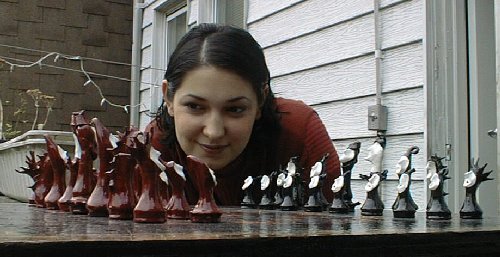Check Mate
Today, we ask if the king of games is dead. The University of Houston's College of Engineering presents this series about the machines that make our civilization run, and the people whose ingenuity created them.
Shah Mat! The Persian words announce that the king is dead. The English version, Check Mate, says the chess king has died. Now computers have chess itself, the king of games, under attack.
The first chess-playing robot showed up in the 1760s. Later, that same machine drove Napoleon to rage by beating him in 19 moves. But it wasn't really a machine at all. It was a trick. A small chess master sat in the apparatus pulling levers.
Edgar Allan Poe was one person who guessed the secret. It couldn't be a real machine, he said, because it made mistakes. He'd made the right conclusion for the wrong reason. Nineteenth-century determinism expected machines to be perfect. Now we do better by giving machines some room to make mistakes.
Programing a computer to win at chess is difficult. It was 1958 before we could even tell one how to follow the rules of chess. It was 1966 before we had a program that could compete with the average tournament player.
This might seem to be frivolous stuff for serious engineers. It is not. Beneath the surface lie important questions about the way computers think.
By the '60s, computer people had split into two camps. Some thought they should imitate the strategies of chess masters. Others said "No, use brute force." All a machine has to do to beat a human is to look at all possibilities --10 or 15 moves ahead.
For twenty years, brute-force computers marched through the tournament chess ranks. Those machines became experts -- then masters. Finally, they threatened even senior masters. Only grand masters remained out of reach.
Then four students at Carnegie-Mellon added learning ability to brute force. They made a new chess-playing computer called Deep Thought, and they turned it loose on the great chess players. Deep Thought became the first mechanical grand master. It's rating is on the low end of the scale, but it's there.
Now the four've picked up IBM support. They promise a new version of Deep Thought in 1992. Kasparov allows it might beat the general run of grand masters. "But not Karpov and me!" he adds. So the battle lines are drawn -- man vs. machine. I rather expect Deep Thought will beat Karpov and Kasparov in the end.
But I won't credit the victory to the machine. The students point out that it's their collective -- and quite human -- mind up against the masters. In the end, the combat isn't man against machine at all. It's four good minds -- against just one.
I'm John Lienhard, at the University of Houston, where we're interested in the way inventive minds work.
(Theme music)
Hsu, F-h., Anantharaman, T., Campbell, M., and Nowatzyk, A., A Grandmaster Chess Machine. Scientific American, Vol. 263, No. 4, Oct. 1990, pp. 44-50.
The question, "Can a computer beat a Grand Master?" was resolved, just under seven years after I wrote this episode in 1990, by Deep Blue's victory over Kasparov. See Episode 1242.

Modern chess set created by Stephanie Lienhard (pictured)